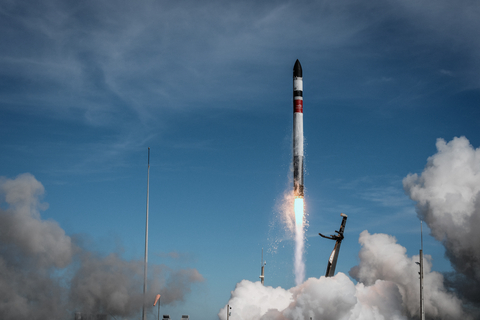Rocket Lab Successfully Deploys Satellites ~500km Apart to Separate Orbits For KAIST and NASA
Following payload deployment to two separate orbits, Electron’s Kick Stage completed a final engine burn to lower its altitude and speed up its reentry to help reduce space junk
MAHIA,

Successful lift-off for Rocket Lab's 47th Electron launch carrying two missions for KAIST and NASA. (Photo: Business Wire)
The “Beginning Of The Swarm” (B.T.S.) mission lifted-off from Rocket Lab Launch Complex 1 in Mahia,
NEONSAT-1 will perform Earth-observation of the Korean Peninsula for KAIST, which will then pair the satellite’s data with artificial intelligence to monitor for natural disasters in the region. NEONSAT-1 is the first of 11 satellites for KAIST’s planned constellation to image the Korean Peninsula several times daily.
The second mission deployed today was NASA’s Advanced Composite Solar Sail System, which is a technology demonstration of new materials that use sunlight to propel a spacecraft. Much like a sailboat is powered by wind pushing against a sail, solar sails employ the pressure of sunlight for propulsion to move around. This mission plans to test how well new composite booms unfurl the sail from the spacecraft – which is about the size of a toaster – to an area about the size of a small apartment. Data from this mission will be used for designing future larger-scale composite solar sail systems for space weather early warning satellites, asteroid and other small body reconnaissance missions, and missions to observe the polar regions of the sun.
The capability to deploy two satellites more than 500km apart on the same launch is enabled by Electron’s Kick Stage, a small stage with engine relight capability to enable last-mile delivery. After deploying NEONSAT-1, Electron’s Kick Stage completed multiple in-space burns of its Curie engine to raise its apogee and circularize its orbit before deploying the Advanced Composite Solar Sail System spacecraft. The Kick Stage then completed a fourth and final engine light to perform a deorbit maneuver that returned the stage closer to Earth to speed up its eventual deorbit, helping to reduce long term orbital debris.
Today’s successful mission was Rocket Lab’s fifth launch of 2024, continuing Electron’s streak as the United States’ second-most frequently launched rocket annually.
Details of Rocket Lab’s next Electron mission will be announced shortly.
+ About Rocket Lab
Founded in 2006, Rocket Lab is an end-to-end space company with an established track record of mission success. We deliver reliable launch services, satellite manufacture, spacecraft components, and on-orbit management solutions that make it faster, easier, and more affordable to access space. Headquartered in
+ Forward Looking Statements
This press release contains forward-looking statements within the meaning of the Private Securities Litigation Reform Act of 1995. We intend such forward-looking statements to be covered by the safe harbor provisions for forward looking statements contained in Section 27A of the Securities Act of 1933, as amended (the “Securities Act”) and Section 21E of the Securities Exchange Act of 1934, as amended (the “Exchange Act”). All statements contained in this press release other than statements of historical fact, including, without limitation, statements regarding our launch and space systems operations, launch schedule and window, safe and repeatable access to space, Neutron development, operational expansion and business strategy are forward-looking statements. The words “believe,” “may,” “will,” “estimate,” “potential,” “continue,” “anticipate,” “intend,” “expect,” “strategy,” “future,” “could,” “would,” “project,” “plan,” “target,” and similar expressions are intended to identify forward-looking statements, though not all forward-looking statements use these words or expressions. These statements are neither promises nor guarantees, but involve known and unknown risks, uncertainties and other important factors that may cause our actual results, performance or achievements to be materially different from any future results, performance or achievements expressed or implied by the forward-looking statements, including but not limited to the factors, risks and uncertainties included in our Annual Report on Form 10-K for the fiscal year ended December 31, 2023, as such factors may be updated from time to time in our other filings with the Securities and Exchange Commission (the “SEC”), accessible on the SEC’s website at www.sec.gov and the Investor Relations section of our website at www.rocketlabusa.com, which could cause our actual results to differ materially from those indicated by the forward-looking statements made in this press release. Any such forward-looking statements represent management’s estimates as of the date of this press release. While we may elect to update such forward-looking statements at some point in the future, we disclaim any obligation to do so, even if subsequent events cause our views to change.
View source version on businesswire.com: https://www.businesswire.com/news/home/20240423558620/en/
+ Rocket Lab Media Contact
Murielle Baker
media@rocketlabusa.com
Source: Rocket Lab USA, Inc.









